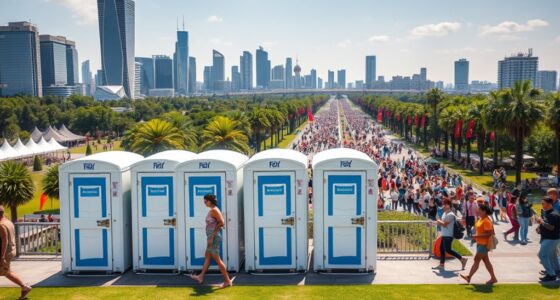Providing you with accessible, well-designed restroom facilities can boost your productivity and well-being at work. Good restroom access reduces stress, minimizes interruptions, and keeps you focused. Ergonomic features such as proper lighting, space, and cleanliness make the experience more comfortable, supporting both your physical and mental health. Prioritizing these facilities shows you care about employee wellness. If you stay with us, you’ll discover how strategic restroom design can create a healthier, more efficient workplace environment.
Key Takeaways
- Access to clean, ergonomic restrooms reduces employee stress and interruptions, enhancing overall productivity and well-being.
- Well-designed restroom facilities minimize wait times and disruptions, allowing employees to focus better on their tasks.
- Inclusive restroom layouts support employees with physical limitations, promoting a more engaged and comfortable workforce.
- Proper hygiene facilities encourage good health practices, decreasing illness-related absences and maintaining consistent productivity.
- Prioritizing restroom quality demonstrates organizational care, boosting employee satisfaction, loyalty, and workplace morale.

A healthy workforce is essential for any organization’s success, yet many employers overlook the importance of wellness initiatives. One often-neglected aspect that can profoundly influence employee productivity and overall well-being is access to well-designed restroom facilities. When employees have convenient, clean, and comfortable restroom options, it reduces stress and interruptions during the workday, allowing them to stay focused and efficient. This is especially true when considering mental health. Constantly worrying about finding a restroom or enduring uncomfortable facilities can increase anxiety and distract employees from their tasks. By prioritizing ergonomic design in restroom spaces—such as sufficient space, proper lighting, and thoughtful placement—you support mental health and create a more comfortable environment. Employees who feel cared for tend to experience less stress and are more likely to maintain a positive attitude toward their work.
Investing in ergonomic design isn’t just about aesthetics; it’s about functionality and comfort. When restrooms are accessible and thoughtfully designed, employees don’t waste time searching for facilities or waiting in long lines. This seamless access minimizes disruptions, helping staff stay engaged and productive. Additionally, ergonomic features like supportive fixtures, adequate ventilation, and user-friendly layouts accommodate all employees, including those with physical limitations. Such considerations demonstrate an employer’s commitment to inclusivity and employee well-being, which can boost morale and loyalty.
Accessible, well-designed restrooms enhance productivity, inclusivity, and employee well-being through seamless, comfortable facilities.
Moreover, good restroom access can reduce health-related absenteeism. When employees feel comfortable and have easy access to hygiene facilities, they’re more likely to maintain good personal health, decreasing the spread of germs and illnesses. This preventative aspect directly benefits productivity, as fewer sick days are taken. It also signals to staff that their comfort and health matter, fostering a culture of care that enhances mental well-being. When workers aren’t preoccupied with discomfort or health concerns, they can focus more fully on their responsibilities.
Ultimately, integrating ergonomic design into restroom facilities isn’t just a matter of convenience—it’s a strategic move that supports mental health, enhances employee satisfaction, and boosts productivity. When your organization recognizes the importance of accessible, well-designed restrooms, you create an environment where employees feel valued and supported. This, in turn, cultivates a more engaged, healthier workforce. Remember, small improvements like better restroom access can have a ripple effect, positively impacting overall workplace wellness and helping your organization thrive.
Frequently Asked Questions
How Does Restroom Accessibility Impact Employee Mental Health?
Restroom accessibility directly influences your mental health by reducing bathroom anxiety, which can cause stress and distraction. When facilities are easily available, you’re less likely to experience mental health stigma or feel embarrassed, fostering a safer environment. This support helps improve your overall well-being, lowers anxiety levels, and encourages a healthier mindset at work, making you feel more comfortable and focused throughout the day.
What Are Cost-Effective Ways to Improve Restroom Facilities?
Have you ever considered how small investments can substantially improve restroom quality? To enhance facilities cost-effectively, focus on regular restroom maintenance and strict hygiene standards. You can implement simple upgrades like improved signage, affordable hand dryers, and routine cleaning schedules. These steps not only elevate cleanliness but also demonstrate your commitment to employee well-being, boosting morale and productivity without breaking the bank. Wouldn’t that create a more inviting workspace?
How Do Restroom Policies Vary Across Different Industries?
Restroom policies differ across industries based on restroom design and hygiene standards. In healthcare or food service, strict hygiene standards lead to frequent cleaning and specialized facilities. In contrast, corporate environments might prioritize spacious, accessible restroom design to enhance comfort. You’ll find that industries with higher customer interaction or safety concerns tend to enforce more rigorous restroom policies, ensuring cleanliness, accessibility, and compliance with health regulations to support employee and customer well-being.
What Are the Legal Requirements for Restroom Access at Work?
Imagine a workplace where restroom access is seamless and compliant, contrasting with one struggling with inadequate facilities. Legally, you must guarantee restroom compliance by providing sufficient, accessible facilities that meet employee hygiene standards. Regulations vary by location, but generally, you’re required to offer enough restrooms based on employee numbers, ensure they’re clean and private, and accommodate disabilities. Staying compliant not only meets legal standards but promotes a healthier, more productive work environment.
How Can Small Businesses Upgrade Restrooms on a Budget?
To upgrade your restrooms on a budget, start by improving restroom signage to clearly direct employees and visitors. Regularly update and follow maintenance schedules to keep facilities clean and functional. Consider inexpensive upgrades like fresh paint, better lighting, or affordable fixtures. These small changes create a more welcoming environment, showing you value employee comfort without breaking the bank. Consistent maintenance and clear signage make a noticeable difference in restroom quality and accessibility.
Conclusion
By ensuring better restroom access, you not only support your employees’ health and comfort but also boost their productivity. Some studies suggest that taking regular breaks to address basic needs improves focus and reduces stress, making your workplace more efficient. So, next time you think about workplace improvements, consider upgrading restroom facilities. It’s a simple step that could lead to happier, healthier employees and a more successful business overall.









